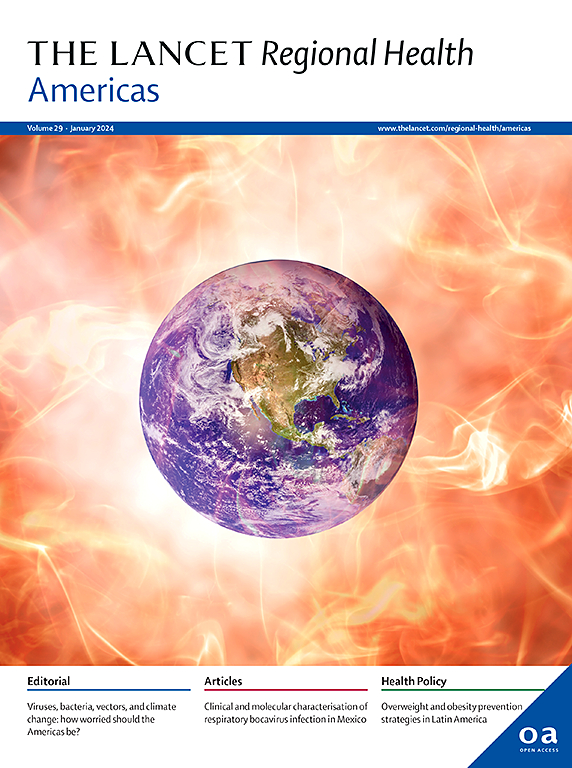Associations of the Philadelphia sweetened beverage tax with changes in adult body weight: an interrupted time series analysis
IF 7
Q1 HEALTH CARE SCIENCES & SERVICES
引用次数: 0
Abstract
Background
Sweetened beverage taxes are associated with large decreases in sugar-sweetened beverage sales, but their effects on weight outcomes are unclear. We examined associations of the 2017 Philadelphia beverage tax with changes in adult weight outcomes.
Methods
We obtained electronic health record data on adults 18–65 years old in Philadelphia (intervention) and other areas of Pennsylvania and New Jersey (control) from 2014 to 2019. Controlled interrupted time series models compared post-tax changes in trends of body mass index (BMI, primary outcome) and obesity prevalence (secondary outcome). A panel sample comprised 175,675 adults with at least one BMI measure in both the pre-tax (2014–2016) and post-tax (2017–2019) periods. A cross-sectional sample comprised 587,121 adults with at least one BMI measure from 2014 to 2019.
Findings
Before tax implementation, Philadelphia panel patients had a mean BMI of 30.4 kg/m2 and an obesity prevalence of 44.5%. After implementation, in the panel sample, there was a −0.03 kg/m2 (95% CI: −0.07, 0.02) per quarter decrease in BMI vs. control, implying a −0.32 kg/m2 (−0.85, 0.20) change at the end of the 3-year study period. In the cross-sectional sample, there was a −0.05 kg/m2 (95% CI: −0.09, −0.01) per quarter decrease in BMI vs. control, implying a −0.60 kg/m2 (−1.04, −0.16) change at the end of the study period. Results for obesity prevalence were consistent with the BMI results.
Interpretation
There was some limited evidence of a decrease in BMI and obesity prevalence in Philadelphia 3 years after beverage tax implementation. Replication of these results is needed.
Funding
National Institutes of Health.
费城甜饮料税与成人体重变化的关系:间断时间序列分析
背景含糖饮料税与含糖饮料销量大幅下降有关,但其对体重结果的影响尚不清楚。我们研究了 2017 年费城饮料税与成人体重结果变化之间的关联。方法我们获得了 2014 年至 2019 年费城(干预)以及宾夕法尼亚州和新泽西州其他地区(对照)18-65 岁成人的电子健康记录数据。受控间断时间序列模型比较了税后体重指数(BMI,主要结果)和肥胖患病率(次要结果)趋势的变化。面板样本包括 175675 名成年人,他们在税前(2014-2016 年)和税后(2017-2019 年)期间至少有一项体重指数测量指标。横断面样本包括 587 121 名成年人,他们在 2014 年至 2019 年期间至少测量过一次体重指数。研究结果在税收实施前,费城小组患者的平均体重指数为 30.4 kg/m2,肥胖率为 44.5%。实施后,在小组样本中,与对照组相比,BMI 每季度下降-0.03 kg/m2 (95% CI: -0.07, 0.02),这意味着在 3 年研究期结束时,BMI 的变化为-0.32 kg/m2 (-0.85, 0.20)。在横断面样本中,与对照组相比,BMI 每季度下降-0.05 kg/m2 (95% CI: -0.09, -0.01),这意味着在研究期结束时会有-0.60 kg/m2 (-1.04, -0.16)的变化。肥胖症患病率的结果与体重指数的结果一致。解释:饮料税实施 3 年后,费城的体重指数和肥胖症患病率有所下降,但证据有限。需要对这些结果进行复制。
本文章由计算机程序翻译,如有差异,请以英文原文为准。
求助全文
约1分钟内获得全文
求助全文
来源期刊

Lancet Regional Health-Americas
Multiple-
CiteScore
8.00
自引率
0.00%
发文量
0
期刊介绍:
The Lancet Regional Health – Americas, an open-access journal, contributes to The Lancet's global initiative by focusing on health-care quality and access in the Americas. It aims to advance clinical practice and health policy in the region, promoting better health outcomes. The journal publishes high-quality original research advocating change or shedding light on clinical practice and health policy. It welcomes submissions on various regional health topics, including infectious diseases, non-communicable diseases, child and adolescent health, maternal and reproductive health, emergency care, health policy, and health equity.
 求助内容:
求助内容: 应助结果提醒方式:
应助结果提醒方式:


